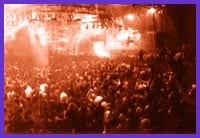Circuit parties are a religious experience.
That’s exactly what some circuit queens report the parties have become: more of a religious ritual than anything else.
In his 1997 book, Life Outside, author Michelangelo Signorile referred to the circuit as “the evangelical or fundamentalist wing of the cult of masculinity.”
And as numbers swell, the gospel appears to be spreading along with it.
“If you think about it, it’s entirely understandable,” says Robert Vezina, ringmaster of Bad Boy Club Montreal, behind the Thanksgiving weekend’s Black And Blue. “What are these parties but a celebration of life?”
Vezina traces the beginnings of spiritual beliefs around circuit parties to the grand-daddy of them all, The Saint, in New York. “Those parties were held under a dome, in a circular space. The cosmos was above you, as in a planetarium. The house music then wasn’t quite as hard as it’s become today.
“The closer you got to the centre of the dance floor, the closer you got to channeling the positive energy, the spiritual energy, there.”
Vezina says that once the events became AIDS fundraisers, that only added to the sense that the parties were spiritual celebrations of life.
“People are still drawn to the centre of the dance floor. Why do we put the mirror ball at the centre of the dance floor? Because it makes for a central energy.”
While Vezina describes himself as “a very spiritual person,” he insists he’s not a flake. “No, I’m not. I’ve read The Celestine Prophecy, but I’ve never read any Shirley MacLaine.”
Steven Baird, a corporate lawyer and chair of the annual Winter Party in Miami, says he considers himself a “priest of the circuit.” Baird argues that whenever groups of people get together, with the exception of work for pay, there is the potential for a communal or spiritual sense arising.
“People attend church far less than they used to. Often, people, even unconsciously, are looking for these experiences to feel part of a larger group.”
Baird – whose father is a Presbyterian minister – says he grew up surrounded by religious ritual. “For me, the idea of going to a circuit party or a disco on Saturday night is no different than the idea of going to church on Sunday.
“Not everyone feels that, but I often feel like I’m going to church. The circuit really has a different feeling from, say, bars and clubs of the ’70s. Many have images of the circuit that they’ve gained from [journalist and author] Michelangelo Signorile’s criticisms, which are generally completely wrong. The fact is, much of the gay nightlife used to be about lone wolves heading out for the hunt to find sexual partners. The circuit is more about friends getting together. I’m not saying it isn’t sexual, but it’s sexual in a much different way. People mainly go to join the tribe, not to hunt.”
Both Vezina and Baird say that, like the hippies in the 1960s, many circuit queens have found drugs have played a part in their spiritual journey. “It’s difficult to say what relation drugs play to these experiences,” says Baird. “But the idea of intoxicants being involved in communal, spiritual events is an ancient one. After all, they loosen inhibitions.”
“Drugs can have something to do with it,” adds Vezina, “but the base has to be inside of you. If you’re in a bad mood, drugs are just going to extend that. You have to be open to it in the first place.
Some party revelers even report finding something positive in a bad trip. Montreal filmmaker José Torrealba’s feature documentary on the circuit, Got 2B There, is touring international film fests to packed houses and stellar reviews. He says he interviewed people about their spiritual experiences while doing research for the film.
“One guy said he saw flying saucers while having a particularly intense trip. He thought he was going crazy, but then he said he realized it had to do with God, so he was okay with it.”
BAD BOYS
Toronto politicians have gone bezerk over raves.
A task force will look at regulating them. Most recently, a handful of Queen St partyers went to hospital after buying Ecstasy that was laced with rat poison.
In November, provincial Consumer Affairs Minister Bob Runciman announced he hoped to impose so many restrictions on all-night raves that it would almost impossible to hold them.
He also said that there have been three rave-related drug deaths in the last few months.

 Why you can trust Xtra
Why you can trust Xtra


